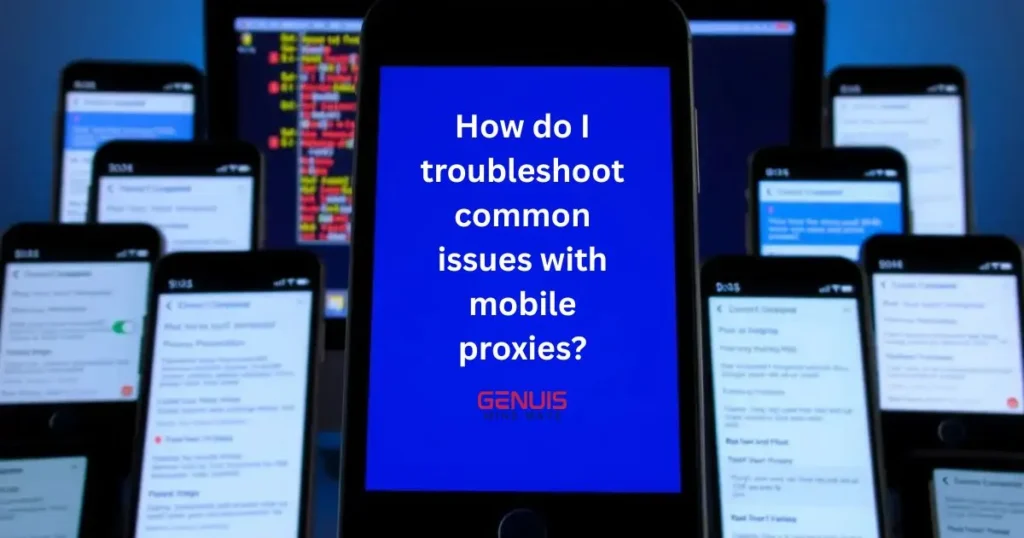How do I troubleshoot common issues with mobile proxies? If you are experiencing problems with your proxies, don’t worry!
This post discusses typical causes and fixes to assist you in getting back on track. Over time, mobile proxies face challenges like proxy configuration issues, high latency, and target website blocking.
This guide points out each problem, with simple steps and helpful explanations, so that you can resolve issues fast and effectively.
How Do I Troubleshoot Common Issues with Mobile Proxies?
Firstly, troubleshooting starts by understanding common proxy errors. You should check your settings, look for error codes, and test your network. You may face DNS errors with proxies or unstable connections.
Secondly, a structured workflow helps. Start from the account level (like subscription renewal) and step down to your app configuration. This way, you resolve problems systematically without guesswork or repeated fixes.
What Are Mobile Proxies?
Moreover, mobile proxies route your internet requests through a real cellular network. This makes them harder to block than the data centre proxies. They deliver a rotation of IPs every few minutes, which mimics real user behaviour online.
Also, these proxies help avoid simple IP bans and let you test geo-specific sites. They behave like you’re browsing from a phone, so websites trust your connection more than server-based proxy connections.
What Are the Benefits of Proxies?
Proxy servers also help keep data safe and increase privacy. Proxy servers let businesses do things like web scraping, ad verification, and automation without giving away their real IP address.
Mobile proxies also let you get around location restrictions and give dynamic IP rotation.
Why Are They Different?
Besides typical proxies, mobile proxies connect through carriers. They use cell towers, giving you realistic network conditions that mimic everyday mobile users.
On top of that, their IPs rotate frequently and appear genuine. This reduces detection and prevents many anti-bot systems from blocking your access.
Why Do Mobile Proxies Stop Working Suddenly?
However, proxies can fail when your account faces issues like missed subscription renewals or hitting bandwidth limits. These happen silently but kill your connectivity.
Next, network or app updates can break proxy authentication methods. Always test connections after making changes to avoid unexpected downtime.
How Do I Diagnose Proxy Authentication Problems?
Firstly, incorrect credentials or the absence of IP allowlisting can prevent traffic. You need to verify username/password combos or IP lists for mobile proxies.
Secondly, check your activity page monitoring for error codes like 407. Misconfigured credentials or missing access rights often cause this issue.
What should I do if my proxy shows high latency or is slow?
Moreover, slow proxies frustrate tasks. High lag often happens when using proxies far away or with poor network coverage.
Then, try the direct connection method. Connect to a nearby endpoint and compare speeds. This procedure can fix speed slowdowns caused by bad routing or distant servers.
How to Fix IP Allowlisting and Access Restrictions?
Also, many services block unknown IPs by default. You must authenticate proxies by IP before accessing such sites.
Next, review your dashboard’s IP settings. A slight typo in the IP range can stop access completely. Correcting it restores your connections quickly.
What should you do if you encounter no internet access while using a proxy?
Meanwhile, no internet at all usually means incorrect protocol or blocked firewall rules. Check if TCP or HTTPS is selected correctly in your client.
Then, test the connection without proxies. If that works, your proxy config is faulty. If it doesn’t, the issue lies with the local network or ISP.
What are the steps to resolve device- or app-level configuration issues?
Next, mobile apps sometimes cache old proxy details. Connection problems are frequently resolved by reinstalling the program or clearing the cache.
Also, operating systems may block proxy ports by default. Enabling your proxy port in settings can resolve this instantly.
When Should You Rotate or Replace the Proxy?
Moreover, rotating proxies prevent target website blocking due to repeated use. Change proxies if you get access denied or see 403 errors.
Especially after 500 requests from one IP, rotation helps maintain reliability and avoids triggering anti-bot systems.
How Many Types of Mobile Proxies Are There?
There are three key proxy types distinguished by IP source and trust level.
Server Proxies
They use datacenter IPs. These proxies are fast but easy for websites to detect and block.
Residential Proxies
They use real home IPs from ISPs. These are more reliable than server proxies, although they are slower.
Mobile Proxies
They use actual mobile carrier IPs. They are the most trusted type and work best for mobile-optimised services and apps.
Why Is It Better to Use Mobile Proxies?
Moreover, mobile proxies give you unique IPs that change often, which avoids detection and blocking.
They also better mimic a real user’s browsing style. This helps reduce high latency from outdated routes and gives you more stable access.
Final Troubleshooting Checklist for Mobile Proxies
Here’s a clear list of possible problems that can happen with mobile proxies
1. Proxy configuration issues;
Incorrect settings or using the wrong connection protocol can stop the proxy from working.
2. Subscription renewal problems;
If your plan expires, your mobile proxies will be paused until you renew it.
3. Bandwidth limits;
Once you hit your data limit, your proxies will stop working until the limit resets or you upgrade.
4. Errors with the proxy login method;
The proxy won’t join if your username, password, or IP address is wrong.
5. High latency;
If the proxy site is far away from you, it can slow down your connection and make pages take longer to load.
6. Unstable connection;
A weak internet signal or a faulty ISP connection can make your proxy drop again and again.
7. DNS errors with proxies;
If DNS settings are wrong, websites may not open correctly through the proxy.
8. Target website blocking;
Some websites detect and block proxy IPs, especially if they see too many requests.
9. No internet connection via proxy;
If your proxy isn’t set up properly, it can block internet access.
10. Device or app-level configuration issues;
Outdated apps or incorrect settings on your phone can cause proxy failures.
11. Proxy rotation issues;
If IPs aren’t rotated properly, your connection may be blocked or show error codes.
12. Firewalls that block access to the proxy;
The firewall or security on your device could block proxy ports, which would keep you from connecting.
How to fix mobile proxy troubleshooting?
Here’s how to fix each common mobile proxy error using easy, practical steps.
1. Fixing Proxy Configuration Issues
First, check that the proxy settings you used are the same ones your service source gave you. Pick the right proxy IP, port number, and way to log in. Make sure you’re using the right protocol for the platform, such as HTTP, HTTPS, or SOCKS5. The wrong setup causes most connection failures.
2. Fixing Subscription Renewal Problems
If your proxies stopped suddenly, check your subscription. Log in to your provider’s dashboard and confirm your plan status. If it’s expired, renew it. Some platforms pause proxies automatically when the plan ends. That’s what causes “What causes subscription proxy pause?” errors.
3. Fixing Bandwidth Limits
Track how much data you’ve used in your dashboard. If you hit your bandwidth cap, your proxies will stop working. Upgrade your plan to increase the limit or wait for the monthly reset. This prevents problems related to the question.
4. Fixing Proxy Authentication Method Errors
Ensure that you input the correct proxy username and password or add your IP address for IP authentication. Visit your provider’s settings to authenticate proxies by IP. Incorrect details cause the error.
5. Fixing High Latency
Latency problems? Use proxies closer to your location. Choose regions near your physical area and connect using a direct connection method. This improves speed and avoids headaches.
6. Fixing Unstable Connections
If your proxy connection keeps dropping, switch Wi-Fi networks or try mobile data. You can also test stability by changing devices. Some apps block proxies or slow them down.
7. Fixing DNS Errors With Proxies
In your device settings, type a public DNS such as 8.8.8.8 (Google DNS). Sites will also not load if the DNS crashes. Updating your DNS often resolves “proxy configuration errors”
8. Fixing Target Website Blocking
Some websites block proxy IPs. If you see client\_connect\_forbidden\_host (403), switch to a new IP or change proxy types. For example, move from data centre proxies to mobile proxies for better success. Use the Activity page monitoring to check logs.
9. Fixing No Internet via Proxy
First, test your internet without a proxy. If it works, the problem is with the proxy setup. Use the proper credentials and make sure the proxy supports the app or browser you are using. Restart everything. This resolved my firewall proxy access issue, too.
10. Fixing Device or App-Level Configuration Issues
Outdated apps or OS versions can block proxies. Update your browser, mobile app, or system. Reset app permissions or clear cached data. Reinstall if necessary.
11. Fixing Proxy Rotation Problems
If your IP doesn’t rotate or gets banned, go to the provider’s settings and manually force IP rotation. Some platforms auto-rotate; others require a click. This procedure avoids repeated bans and connection drops.
12. Fixing Firewall or Antivirus Blocking
Turn off your firewall or antivirus temporarily and test the proxy. If it works, add an exception rule for proxy connections in the antivirus settings. This method clears “Why are my proxies not connecting?” and internet block issues.
What Actions Can the Target Server Consider Suspicious?
Meanwhile, repeated login attempts, no user agent, or missing headers may seem robotic to servers. These cause quick blocking.
To avoid detection, simulate browsing speed and allow time between requests. Adding randomised headers mimics real user behaviour.
Who Uses Mobile Proxies and Why?
Then, marketers use mobile proxies for ad verification. Developers use them for geo-testing. Security teams employ them for fraud detection. These use cases demand realistic IP rotation and privacy.
Should you use paid or free proxies?
Moreover, free proxies might seem appealing, but they come with downsides. They suffer from poor performance, instability, and high detection risk.
Although paid proxies are pricier, they provide obvious activity page monitoring, assistance, and dependability. You get better uptime and fewer headaches.
Conclusion
Finally, how do I troubleshoot common issues with mobile proxies? You start by checking the account status, configuration, and connectivity step by step. Ensure your IP is allowed, test latency, and rotate proxies proactively. With this guide, you’ll resolve most problems confidently. Stick to these steps, and you’ll keep your mobile proxies running smoothly and efficiently.
Learn how to troubleshoot common mobile proxy issues with easy steps. Fix errors, speed issues, and connection problems fast.
How do I troubleshoot common issues with mobile proxies? Fix speed, access, and connection errors step by step.



